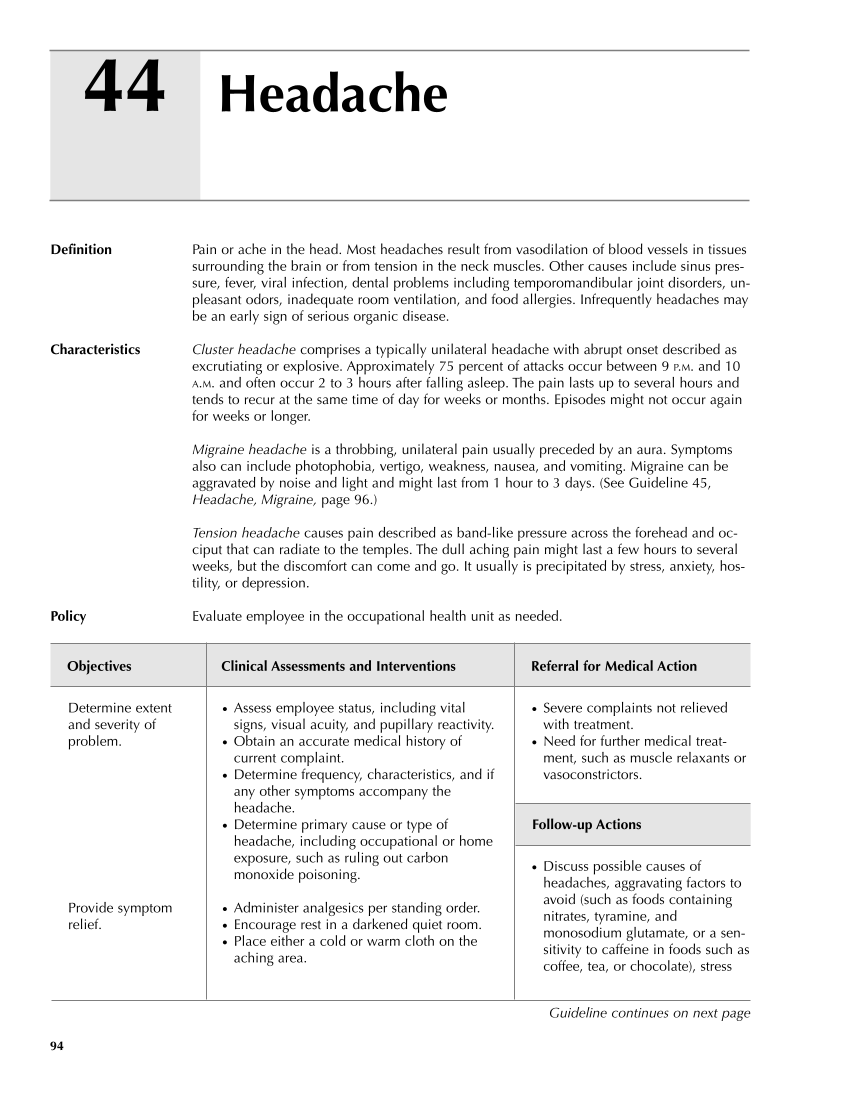44 94 Definition Pain or ache in the head. Most headaches result from vasodilation of blood vessels in tissues surrounding the brain or from tension in the neck muscles. Other causes include sinus pres- sure, fever, viral infection, dental problems including temporomandibular joint disorders, un- pleasant odors, inadequate room ventilation, and food allergies. Infrequently headaches may be an early sign of serious organic disease. Characteristics Cluster headache comprises a typically unilateral headache with abrupt onset described as excrutiating or explosive. Approximately 75 percent of attacks occur between 9 P.M. and 10 A.M. and often occur 2 to 3 hours after falling asleep. The pain lasts up to several hours and tends to recur at the same time of day for weeks or months. Episodes might not occur again for weeks or longer. Migraine headache is a throbbing, unilateral pain usually preceded by an aura. Symptoms also can include photophobia, vertigo, weakness, nausea, and vomiting. Migraine can be aggravated by noise and light and might last from 1 hour to 3 days. (See Guideline 45, Headache, Migraine, page 96.) Tension headache causes pain described as band-like pressure across the forehead and oc- ciput that can radiate to the temples. The dull aching pain might last a few hours to several weeks, but the discomfort can come and go. It usually is precipitated by stress, anxiety, hos- tility, or depression. Policy Evaluate employee in the occupational health unit as needed. Objectives Clinical Assessments and Interventions Referral for Medical Action Headache ● Severe complaints not relieved with treatment. ● Need for further medical treat- ment, such as muscle relaxants or vasoconstrictors. Follow-up Actions ● Discuss possible causes of headaches, aggravating factors to avoid (such as foods containing nitrates, tyramine, and monosodium glutamate, or a sen- sitivity to caffeine in foods such as coffee, tea, or chocolate), stress Determine extent and severity of problem. Provide symptom relief. ● Assess employee status, including vital signs, visual acuity, and pupillary reactivity. ● Obtain an accurate medical history of current complaint. ● Determine frequency, characteristics, and if any other symptoms accompany the headache. ● Determine primary cause or type of headache, including occupational or home exposure, such as ruling out carbon monoxide poisoning. ● Administer analgesics per standing order. ● Encourage rest in a darkened quiet room. ● Place either a cold or warm cloth on the aching area. Guideline continues on next page
Purchased from OEM Press by (ge corporate access). (C) 2013 OEM Health Information, Inc. All rights reserved.












































































































































































































































































































































































































































